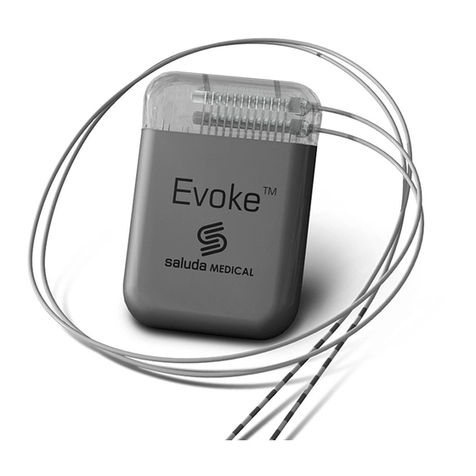
Evoke® SCS System User Manual
1 Description
This User Manual is intended for patients who have received the Saluda® Medical Evoke® SCS
System for either a temporary trial or as a fully implanted system.
The Evoke SCS System is a closed-loop spinal cord stimulation (SCS) system that is intended to
be used to treat chronic pain of the trunk and/or limbs. It stimulates the nerves in your spinal
cord, measures their responses, and can automatically adjust the stimulation level accordingly.
Before receiving a fully implanted system, you will go through a temporary trial period where
you and your doctor can evaluate the system. If you and your doctor feel that the Evoke SCS
System is right for you, you may decide to move to a fully implanted system.
The Evoke SCS System comprises several key parts to deliver your therapy:
•Evoke External Closed-Loop Stimulator (eCLS). During the trial stimulation period, your
percutaneous leads will be connected to the Evoke eCLS. The eCLS is an external
stimulator that you wear during your trial stimulation period. The eCLS delivers
automatic or manually controlled therapy through your percutaneous leads. The eCLS
has a removable battery which is charged by a clinician or Saluda Medical
representative.
•Evoke Closed-Loop Stimulator (CLS). The Evoke CLS is a totally implanted spinal cord
stimulator that connects to your percutaneous leads and is implanted under the skin for
long-term therapy. The CLS delivers automatic or manually controlled therapy through
your percutaneous leads.
•Evoke 12C Percutaneous Leads. The Evoke 12C Percutaneous Leads are placed in the
epidural space overlying your spinal cord and are connected to the eCLS for a trial
period, or permanently implanted and connected to the CLS for long-term therapy. You
may have 1 or 2 percutaneous leads implanted, and there are 12 electrodes on each
lead. This gives your clinician the ability to find the stimulation settings that best give
you pain relief.
•Evoke 12C Lead Extensions. The Evoke 12C Lead Extensions may be used during the trial
period to connect your leads to the eCLS, or they may be permanently implanted to
connect the leads to the CLS if required. Your surgeon will determine if lead extensions
are required.
•Evoke Pocket Console (EPC). The EPC allows you to control your therapy and monitor
your stimulator (either a CLS or eCLS). The EPC and the stimulator communicate with
each other wirelessly. The EPC kit also includes a magnet, which allows you to stop
stimulation from the CLS or eCLS without using the EPC.
•Evoke Charger. The Evoke Charger allows you to recharge the battery in your stimulator
(CLS). The Charger coil (attached to the Charger) is placed on clothing covering the skin
over the implanted CLS and charge is transferred wirelessly to the CLS. The Charger is
battery operated, and a power adapter is included in the kit for recharging the battery in
the Charger.
CLIN-UMAN-005176 Revision: 4.01 Page 4 of 53
































